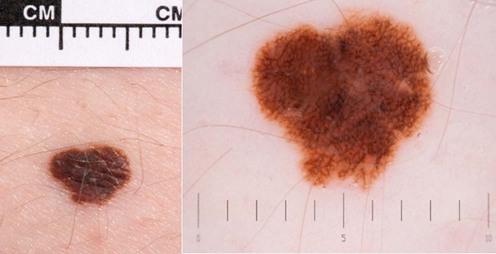I use the term ‘atypical nevi’ to mean nevi that others might call dysplastic nevi. Treatment strategies for atypical nevi: – in the absence of worrying dermoscopic features – reassure but give photographic information about monitoring – if borderline consider photograph and review at 3 months – excise if melanoma cannot be excluded after dermoscopy – consider excision if nevus is new and/or the patient is over 50 years – excise nevi if melanoma cannot be excluded (not usually necessary) – assess risk based upon clinical appearance and family history – consider genetic counseling if three or more cases of melanoma in the family, especially if those cases have multiple primaries or pancreatic cancer (www.genomel.org) – photograph atypical nevi at high magnification and with dermoscopy – educate the patient and partner about self-examination – educate the family about sun protection without becoming vitamin D deficient
Atypical nevi

 Taking a detailed family history to determine if cases of melanoma have occurred in the family. Risk estimation is strongly modified by family history (see www.genomel.org)
Taking a detailed family history to determine if cases of melanoma have occurred in the family. Risk estimation is strongly modified by family history (see www.genomel.org)
 Education about monitoring of nevi
Education about monitoring of nevi
 Follow-up/supervision in clinic, for a period whose length is determined by risk estimation based upon family or personal history of melanoma, the competency of the patient in self examination and the clinical phenotype
Follow-up/supervision in clinic, for a period whose length is determined by risk estimation based upon family or personal history of melanoma, the competency of the patient in self examination and the clinical phenotype
 Excision of atypical nevi where it is necessary to exclude melanoma
Excision of atypical nevi where it is necessary to exclude melanoma
 Education about ensuring sufficient sun protection without becoming vitamin D depleted. Sunburn avoidance is crucial in that sunburn is established to be associated with melanoma risk in multiple studies. Sunbathing, independently of sunburn may also increase risk so should be avoided in those with atypical moles.
Education about ensuring sufficient sun protection without becoming vitamin D depleted. Sunburn avoidance is crucial in that sunburn is established to be associated with melanoma risk in multiple studies. Sunbathing, independently of sunburn may also increase risk so should be avoided in those with atypical moles.
Management strategy
![]()
Stay updated, free articles. Join our Telegram channel

Full access? Get Clinical Tree


Atypical nevi


